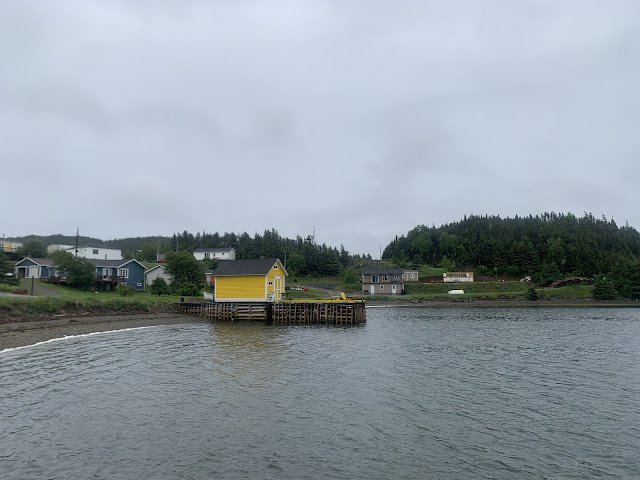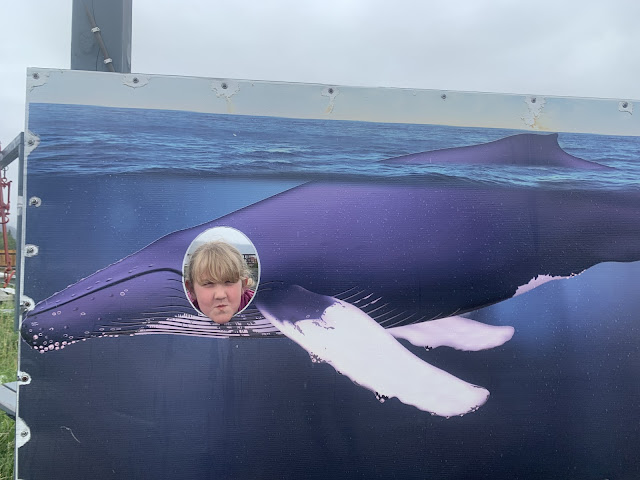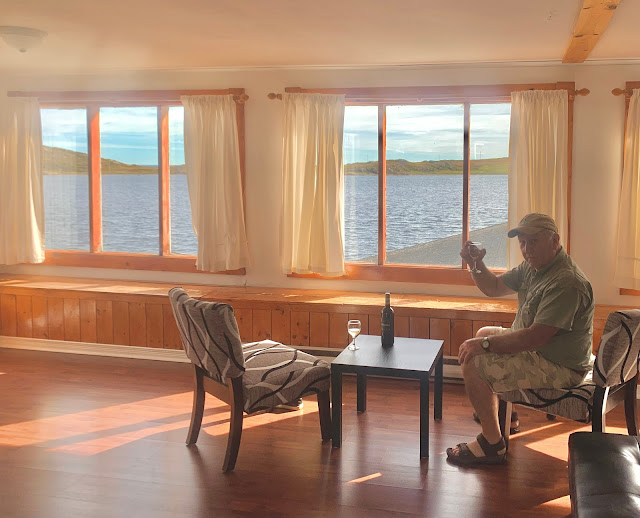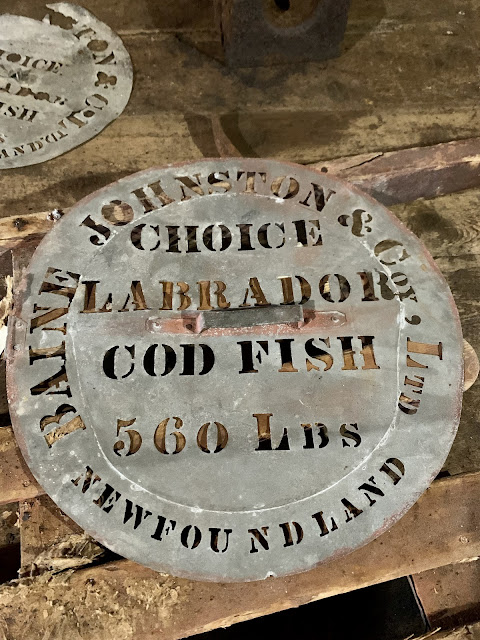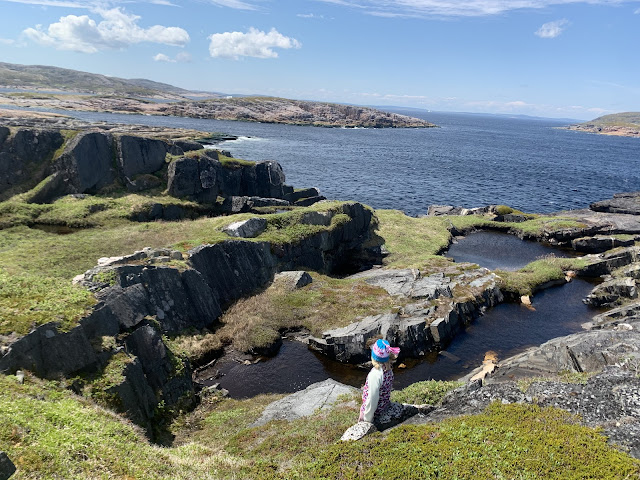Don has always wanted to go to Battle Harbour so this was the year it was meant to be. We were joined by Molly and Dawn and began our driving holiday only to be stopped on the highway for hours due to a traffic accident. So we decided to turn back and explore a bit of Green Bay on a gray, rainy day.
There are many small communities with different names…
The cove in Harry’s Harbour was very still…
Lots of colorful fishing sheds along the way…
We found the Glassy Beach…
We also visited the whales in King’s Point…
After many hours delay we drove as far as Hawkes Bay for the night and the next morning started with a visit to the playground with swings that had an ocean view
The ferry ride took about 90 minutes and was quite pleasant…
Molly and Dawn enjoying the sunny weather on deck.
The scenery was stunning…
We stopped along the way to visit the look outs and the historic sites…
This is the Point Amour Lighthouse which is located near L’anse Amour in southern Labrador. It was completed in 1857 and is the tallest lighthouse in Atlantic Canada and the second tallest one in all of Canada reaching a height of 109 feet. Unfortunately it was closed for the day so we couldn’t get inside.
Checking out the views…
The end of this day found us in Red Bay which is also a National Historic Site. We stayed in an old Stage Head overlooking the water…
With great views…
Time for a drink to end the day…
Up early the next day to drive to Mary’s Harbour to catch the boat to Battle Harbour…
It was another sunny day by the time we got to the wharf.
So what is the attraction to taking a boat to Battle Harbour?
Battle Harbour is a restored, 19th-century fishing village located on a small island 9 miles offshore in the Labrador sea. Regarded by generations as the unofficial capital of Labrador, it was once the salt fish capital of the world.
Off we go….
The boat trip takes about an hour across St. Lewis Inlet and we passed a number of smaller icebergs with much larger ones in the distance….
Our first glimpses of Battle Harbour as we round the point, it is not a large island, about 1 km…
Here you can see the small houses, stages as well as the church on the hill…as we get closer we see the dock with a couple of sailing boats tied up for the night because of the wind…
We stayed in the Issac Smith Cottage which was built sometime between 1830 and 1850 and is the oldest standing residence in Battle Harbour
It is a biscuit style house with very low ceilings and quite charming…
Loved the kitchen…
Cozy bedrooms…
The first day we got there we did a walking tour with Nelson Smith who grew up and worked in the fishery in Battle Harbour. He was a font of knowledge as he took us around and explained the history of the place.
Lying just north of the old French Shore, Battle Harbour served as the gateway for Newfoundlanders seeking to fish in the resource rich waters of Labrador. The local population increased rapidly after 1820 when Newfoundland fishing schooners adopted Battle Harbour as their primary port of call and made it the recognized capital of the Labrador fishery. Battle Harbour remained in the hands of Slade and Co. until 1871, and during this time became a settled community, dominated by the fish merchants, but with its own evolving institutions, especially schools and churches.
Here the group is going into one of the many mercantile buildings associated with the fishery…the Salt Store.it has historic value due to its age and as a physical reminder of a time when the cod fishery was the main industry in Newfoundland and Labrador. Studies suggest that the Salt Store was built in the first half of the 19th century. It was built to store salt, which would be delivered to the first floor and stored on the second floor. The fishery required tonnes of salt which was brought to Battle Harbour by schooners from Spain and Portugal.
The men fished in small boats that would be loaded down with fish to be salted and stored until the merchant’s agent would grade and buy it at the end of the season. Since it was a cashless system the fisher people would often make little or no money by the time they paid for their supplies which they had to purchase from the merchant’s store.
The fishery enterprise at Battle Harbour was eventually sold to Baine Johnston Co from St. John’s in 1871 and then in 1955 to The Earle Freighting Service Ltd. who continued the site’s operation until the decline in the inshore fishery at the start of the 1990s.
When you step off the ferry you feel as if you have stepped back in time as there are no roads, no electricity and the buildings are restored to their historic past. Here are some pictures of the community…
The weather was sunny and very windy while we were there…
Some of the buildings are private residences where owners come to spend the summer months.
Here is the stained glass window from St. James Anglican Church which was started in 1852 and finished in 1857. It is the oldest non- Moravian church in Labrador. All of the furnishings in the church date from its consecration and reflect the Gothic theme of the Church.
During the summer months when the fishing boats would arrive to Battle Harbour the population would swell to several thousands. These residents would be called “ floaters” and the permanent settlers would be called “ livyers”. It was determined that a church should be built to meet the spiritual needs of both the resident and migratory population.
Of course, there is always the food to add to an enjoyable visit. One of the buildings has been renovated into a dining hall and kitchen…
Here Molly and her new friend, Juliette from Quebec City learn how to make bread from the head chef, Daphne.
There is also the general store…
One of the many lookouts…
Looking back on the town…
Very barren but lots of signs of bakeapples…
Trying not to blow away…
Walking out to see the Marconi Towers which were originally built in 1904 and provide much needed communication for the residents.
The trail follows the old footpaths…
One of the old cemeteries…
Looking back on the town…
Very barren but lots of signs of bakeapples…
Trying not to blow away…
Walking out to see the Marconi Towers which were originally built in 1904 and provide much needed communication for the residents.
The rocky shoreline…
Molly decided to call this place…Molly’s Pond.
A winter coat and hat at the end of June…
The evenings were spent at The Loft where we could share a drink and listen to some entertainment…
And finally the sunsets were awesome…
We really enjoyed our trip to Battle Harbour but now it was time to catch the ferry back to Newfoundland so Molly could visit the Vikings. It is time consuming and expensive to make the trip to Battle Harbour but after our visit we would certainly recommend it.



